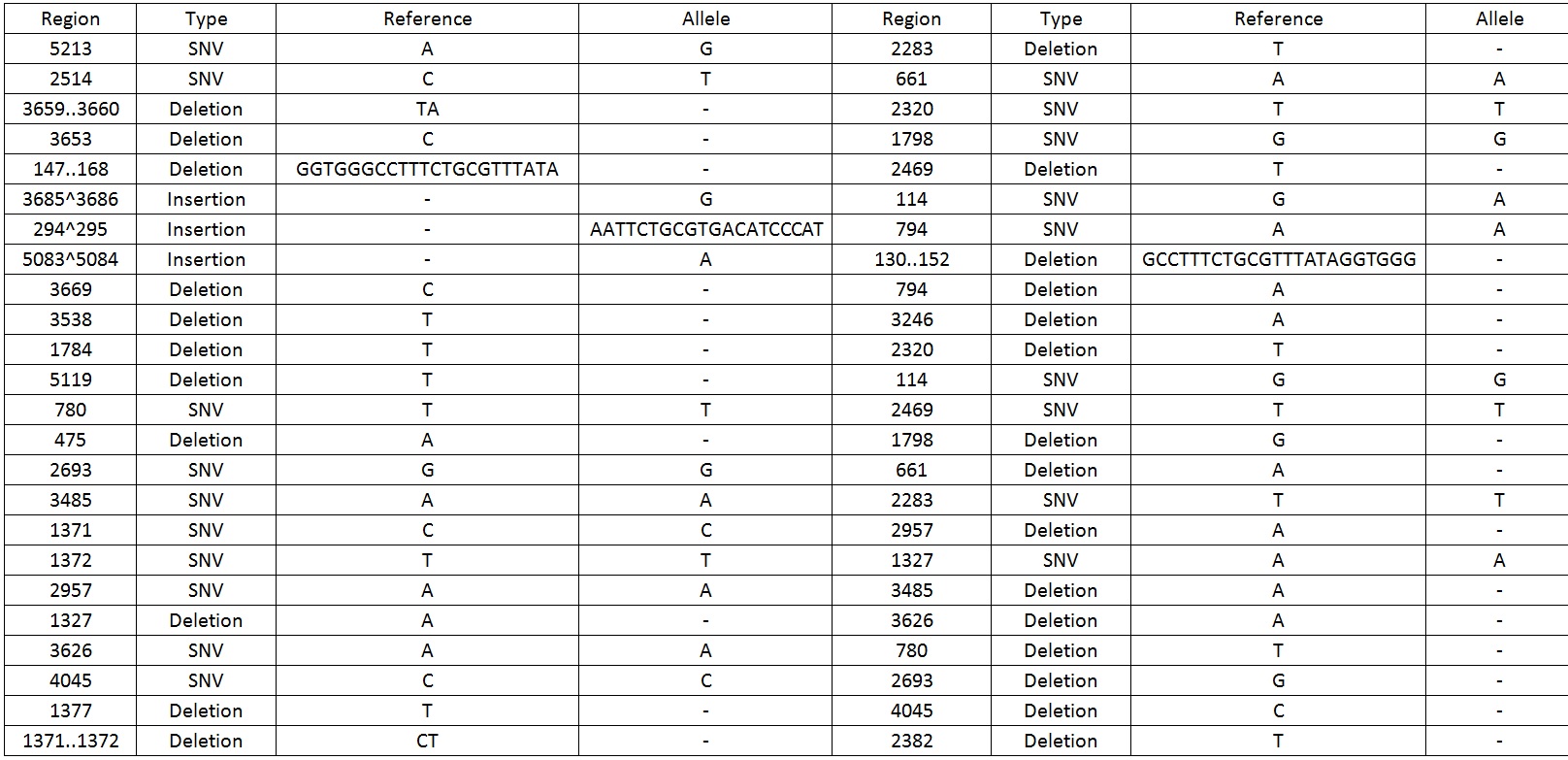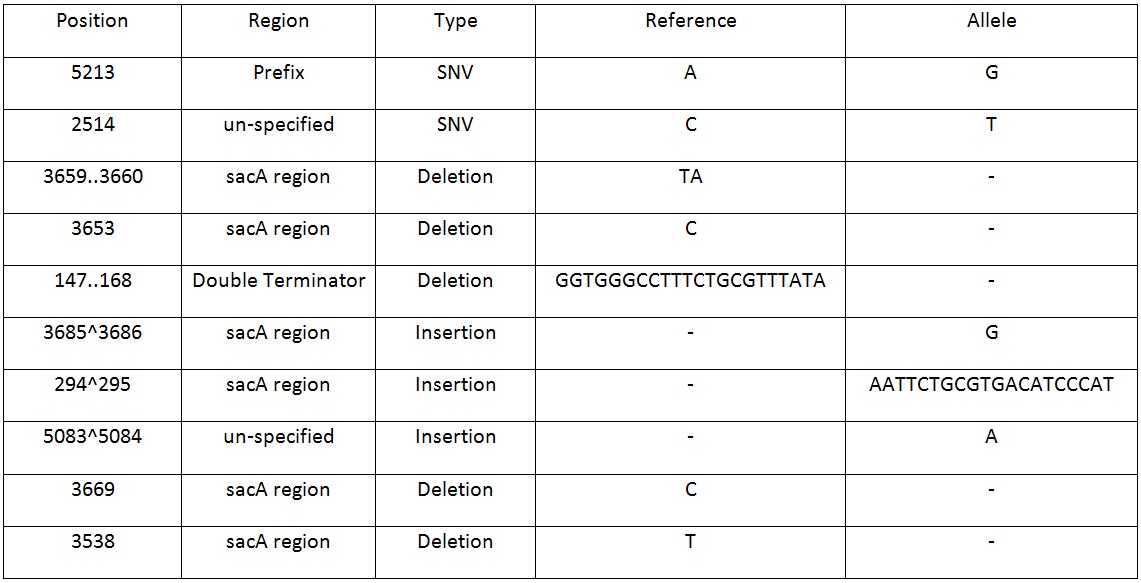Difference between revisions of "Part:BBa K1185004:Design"
(→Design Notes) |
|||
| Line 100: | Line 100: | ||
The results from both sequencing run proved to show similar mutations were found on this backbone, most of the mutations occurred in the sacA integration regions. These results explained the reason why this pSac-Cm derived integration backbone for ‘’B.subtilis’’ were not working. | The results from both sequencing run proved to show similar mutations were found on this backbone, most of the mutations occurred in the sacA integration regions. These results explained the reason why this pSac-Cm derived integration backbone for ‘’B.subtilis’’ were not working. | ||
| − | To get round this problem, we | + | To get round this problem, we have uploaded a new sequence of this pSac-Cm derived integration plasmid. The sequence that we uploaded contain the correct preffix and suffix and also all the correct ''sacA'' sequences for integration in ''B. subtilis''. We have successfully made this backbone not only compatible with ''E. coli'' but also ''B.subtilis''. |
| − | + | ||
| − | + | ||
| − | + | ||
===Source=== | ===Source=== | ||
Latest revision as of 07:31, 4 October 2013
Integration vector for Bacillus subtilis derived from pSac-Cm
- 10INCOMPATIBLE WITH RFC[10]Illegal prefix found at 1
Illegal suffix found at 5190 - 12INCOMPATIBLE WITH RFC[12]Plasmid lacks a prefix.
Plasmid lacks a suffix.
Illegal EcoRI site found at 1
Illegal SpeI site found at 5191
Illegal PstI site found at 5205
Illegal NotI site found at 7
Illegal NotI site found at 5198 - 21INCOMPATIBLE WITH RFC[21]Plasmid lacks a prefix.
Plasmid lacks a suffix.
Illegal EcoRI site found at 1
Illegal BamHI site found at 163 - 23INCOMPATIBLE WITH RFC[23]Illegal prefix found at 1
Illegal suffix found at 5191 - 25INCOMPATIBLE WITH RFC[25]Illegal prefix found at 1
Plasmid lacks a suffix.
Illegal XbaI site found at 16
Illegal SpeI site found at 5191
Illegal PstI site found at 5205
Illegal NgoMIV site found at 4107 - 1000INCOMPATIBLE WITH RFC[1000]Plasmid lacks a prefix.
Plasmid lacks a suffix.
Illegal BsaI site found at 2034
Illegal SapI.rc site found at 3116
Design Notes
We found that that the integration plasmid that groningen send to the registry were unable to integrate in B. subtilis. This is due to the high number of mutations in the sacA integration region.This BioBrick was designed to be used as an integration backbone for the ‘’B. subtilis’’ by integrating at the ‘’sacA’’ region of the endogenous chromosome via double crossover.
The Groningen iGEM 2012 team has showed that this BioBrick can be replicated in ‘’E. coli’’, however have not showed any results/characterisation that this backbone can integrate correctly in ‘’B. subtilis’’.
We transformed this backbone into ‘’B. subtilis’’ but as can be seen in Figure 1, no colonies were found on the ‘’B. subtilis’’ str. 168 + pSac-Cm derived integration plasmid, however the positive control ‘’B. subtilis’’ str.168 + pGFPrrnB (integrates at amyE) did work, which suggested that this backbone was not integrated.
 Plate 1: B. Subtilis str. 168 transformed with pGFPrrnB. |
 Plate 2: B.subtilis str. 168 transformed with H20(negative control). |
 Plate 3: B. subtilis str. 168 with pSac + Cm derived plasmid.
|
Figure 1. Plates of B. Subtilis str. 168 transformed with the pSac+Cm derived plasmid, pGFPrrnB (positive control) and water (negative control). |
We repeated the transformations using higher concentration of plasmids 5ug, 10ug, and 15ug and plated them onto the LB + 5ug/ml Chloramphenicol plates. The results Figure 2, shows that there were colonies growing on the 10ug and 15ug plates.
 B. subtilis str. 168 with 5ug pSac + Cm derived plasmid. |
 B. subtilis str. 168 with 10ug pSac + Cm derived plasmid. |
 B. subtilis str. 168 with 15ug pSac + Cm derived plasmid. |
 B.subtilis str. 168 transformed with H20(negative control) |
 B. Subtilis str. 168 transformed with pGFPrrnB. |
Figure 1. Plates of B. Subtilis str. 168 transformed with 5,10 and 15ug pSac+Cm derived plasmid, pGFPrrnB (positive control) and water (negative control). |
To test for integration, we used the Phenol red Sucrose test; the media where the transformants from the 10ug and 15ug plates were inoculated showed the same results as the control (‘’B. subtilis’’ + pGFPrrnB) with pH ranging between 4.6 – 5.2 suggesting that they could utilized sucrose as their carbon source and produced the acid by products, Figure 3.
Figure 3. Display the pH of each samples following the Phenol Red Sucrose test on overnight grown culture in LB + 1% Sucrose media.
We then sequenced the backbone and found out that there were 49 mutations which include SNV, deletions and insertions.Table 1 display the mutations found on the sequence.
 Table 1. Shows all the mutations found in the BBa_K818000 backbone.
Table 1. Shows all the mutations found in the BBa_K818000 backbone.
Table 2. Shows list of mutations found in the BBa_K818000 backbone, including the position, region and type of mutations after analysing the initial sequencing and the sequencing of highly mutated regions.
 Table 2. Shows list of mutations found in the BBa_K818000 backbone, including the position, region and type of mutations after analysing the initial sequencing and the sequencing of highly mutated regions.
Table 2. Shows list of mutations found in the BBa_K818000 backbone, including the position, region and type of mutations after analysing the initial sequencing and the sequencing of highly mutated regions.
The results from both sequencing run proved to show similar mutations were found on this backbone, most of the mutations occurred in the sacA integration regions. These results explained the reason why this pSac-Cm derived integration backbone for ‘’B.subtilis’’ were not working.
To get round this problem, we have uploaded a new sequence of this pSac-Cm derived integration plasmid. The sequence that we uploaded contain the correct preffix and suffix and also all the correct sacA sequences for integration in B. subtilis. We have successfully made this backbone not only compatible with E. coli but also B.subtilis.
Source
Groningen iGEM 2012 team
References
Middleton, R., Hofmeister, A. New shuttle vectors for ectopic insertion of genes into Bacillus subtilis. Plasmid Volume 51, Issue 3, May 2004, Pages 238–245
Becker E, Herrera NC, Gunderson FQ, Derman AI, Dance AL, Sims J, Larsen RA, Pogliano J. DNA segregation by the bacterial actin AlfA during Bacillus subtilis growth and development. EMBO J. 2006 Dec 13;25(24):5919-31. Epub 2006 Nov 30.

